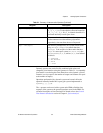
Chapter 3 Building System Connections
Xmath Control Design Module 3-6 ni.com
if the condition estimate for either matrix is less than eps. For more
information on this condition estimate, refer to the MATRIXx Help for the
Xmath function
rcond( ).
Using
Sys to denote the state-space representation for the complete
feedback loop, you can express its component matrices A, B, C, and D
as combinations of the component matrices you obtained from
Sys
1
and
Sys
2
. The full matrices used with two input systems are shown in the next
example. In the case of a constant-gain feedback, A, B, C, and D are
computed using only the matrix partitions shown in bold type.
The initial conditions for the systems are appended to each other
columnwise.
afeedback( ) cannot be used with improper transfer functions—systems
having more zeros than poles—because this algorithm is strictly
state-space.
append( )
Sys = append(Sys1,Sys2)
The append( ) function appends two dynamic systems in a form suitable
for use with the
connect( ) function (refer to the connect( ) section). Sys
A
A
1
B
1s
D
2
C
1
– B
1s
C
2
–
B
2s
C
1
A
2
B
2s
D
1
C
2
–
=
B
B
1s
B
1s
D
2
–
B
2s
D
1
B
2s
=
C
S
1
C
1
⁄ D
1s
C
2
–
D
2s
C
1
S
2
C
2
=
D
D
1s
D
1
D
2s
–
D
2
D
1s
D
2s
=


















